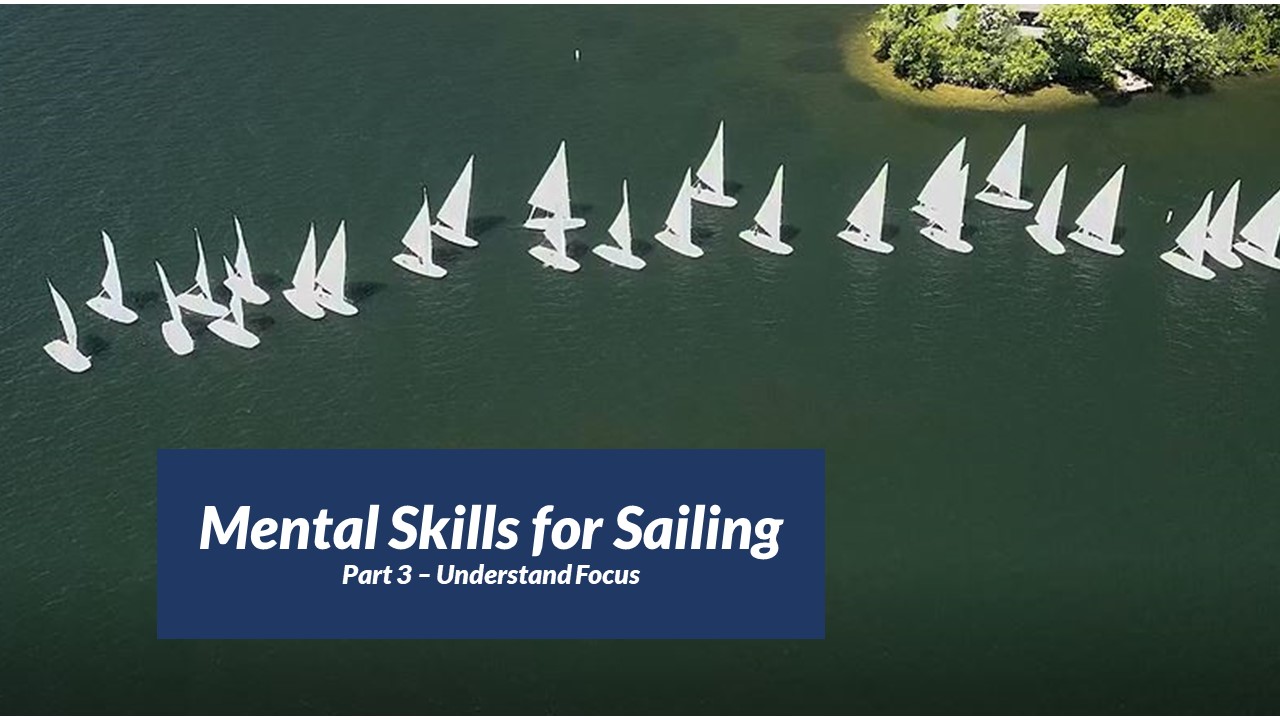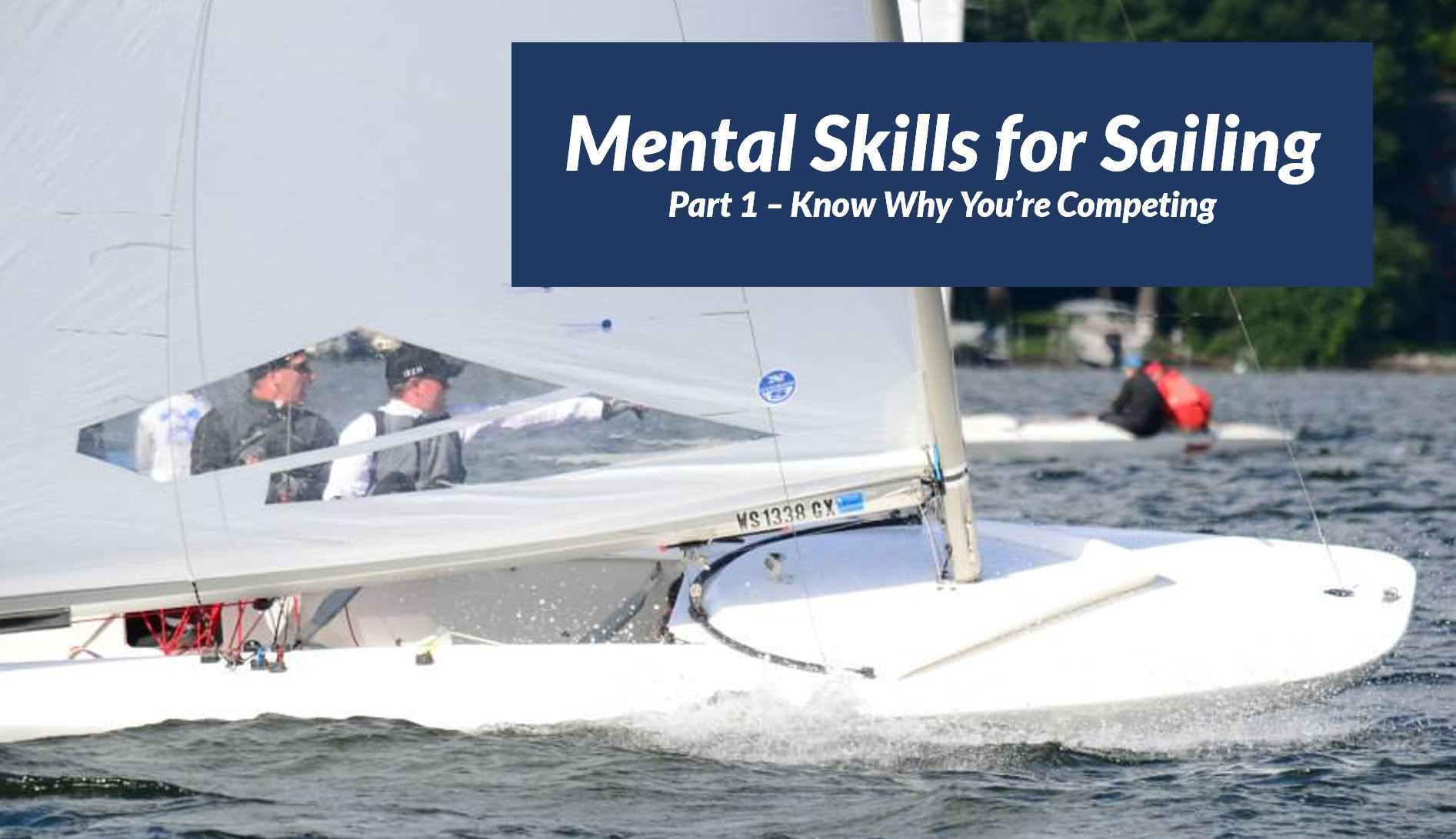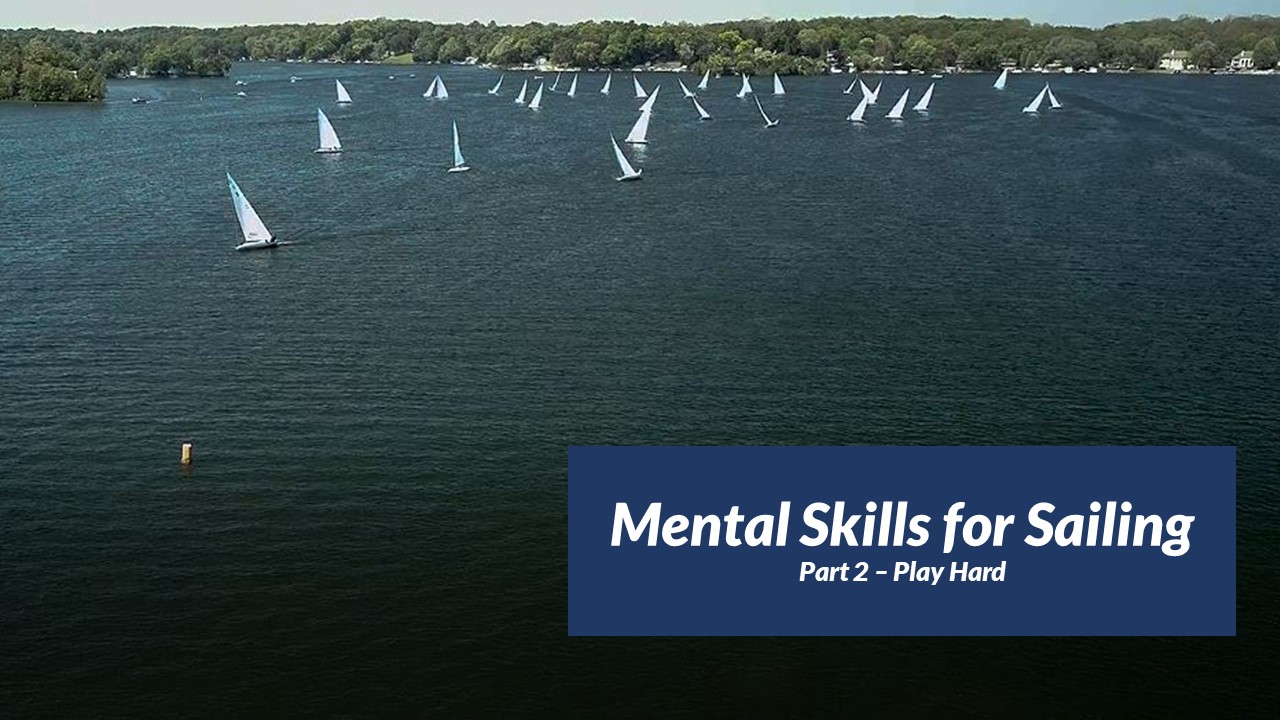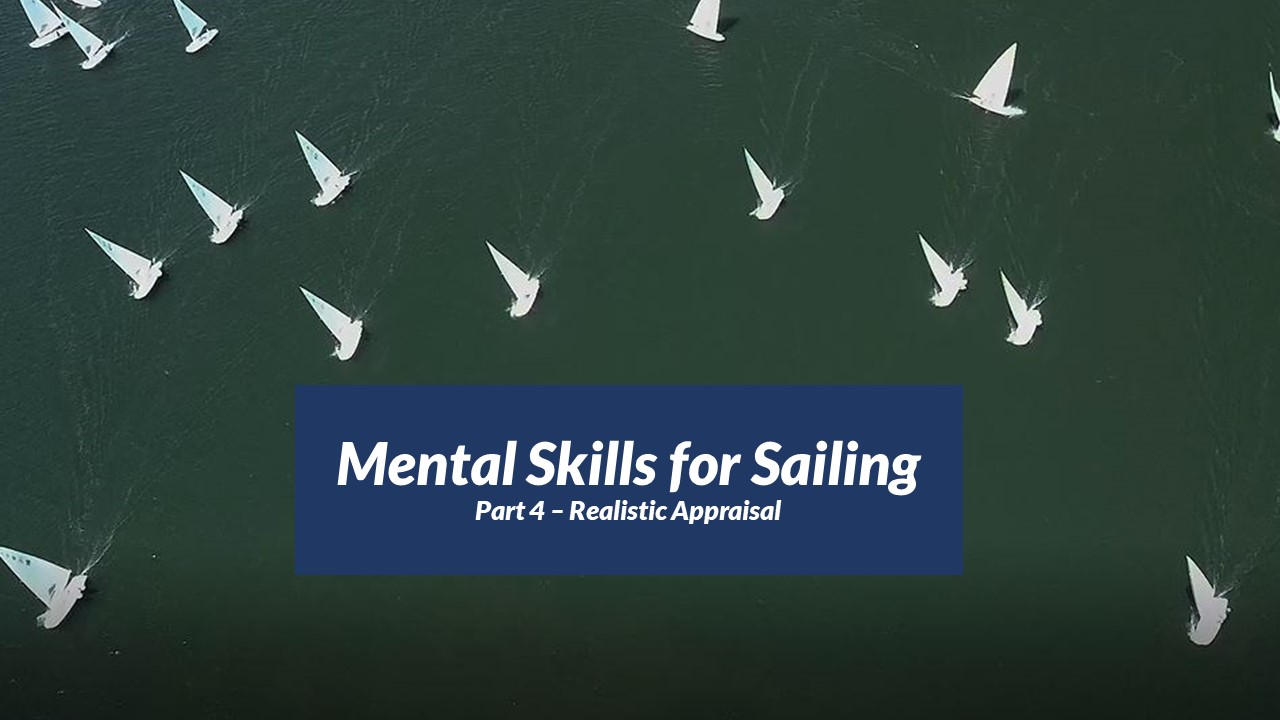Everyone knows you have to “focus” to do well in sailing. But what do you understand focus to mean? Is it urging yourself on, or “concentrating,” or having specific goals? For this article, we reviewed how the experts – both sailors and influential thinkers in other sports – view focus.
Our main sources for this article include:
- The Inner Game of Tennis, by Timothy Gallwey. A classic book on mental aspects, recognized as definitive for all sports. Easy to read.
- Top Dog: The Science of Winning and Losing, by Po Bronson and Ashley Merryman. Integrates the results of research on competition.
- Winning: The Psychology of Competition, by Stuart Walker. Very detailed application of psychology to sailing.
- Sail, Race and Win, by Eric Twiname. How to prepare yourself to win, including several chapters on mental aspects.
Understand Focus
The player of the inner game comes to value the art of relaxed concentration above all other skills.
Timothy Gallwey, The Inner Game of Tennis
Top sailors have recognized the wisdom contained in Gallwey’s The Inner Game of Tennis. Stuart Walker refers to the book in his chapter on concentration and Eric Twiname does so in his chapter on mental preparation.
To Gallwey, focus is simply relaxed observation. Gallwey believes that once you understand focus in this way, it will unlock your ability to perform complex skills without really “trying.”
Focus as Relaxed Observation – Five Characteristics
Let’s look more deeply at five characteristics of “relaxed observation.” If you can put these together consistently, you will understand focus.
#1. Detailed
The more detail you can see, the better your focus. A classic Gallwey example is the suggestion to observe the tennis ball so carefully that you can see the seams and the rotation as it approaches you. Your unconscious mind needs this level of detail to act automatically.
The best sailors are those who can observe more elements of sailing. Can you anticipate wind shifts by the tree leaves on the shore or the heading of boats sailing downwind? Can you tell if you’re going to intercept a puff on the lifted side? As you progress, you can start to expand your powers of observation.
If you’re having trouble with a sailing skill, try to find the right things to observe in detail, so you can self-correct. Gallwey catalogs things to observe for various aspects of tennis. We use an example for gust management below. We plan to develop a more extensive catalog of sailing cues for a future post.
#2. Interested, Relaxed, Non-Judgmental
Observation should feel like the opposite of trying hard. When you observe in detail, your interest level increases, your body relaxes, and you eliminate all forms of judgment.
All the experts agree that judgment is especially poisonous, because it interferes with our ability to observe and react unconsciously. Even a compliment interferes. Unfortunately, we are quick to judge ourselves. Top Dog cites research showing that greater than 10% of our thoughts are self-evaluation by comparison with others.
#3. All Senses
Observing in detail means using all your senses. Sailors are familiar with this, but there is always more we can learn. For example, in sailing, if you are having trouble reacting to puffs, you will benefit from feeling the added tension in the mainsheet and the slight tug on the tiller when a puff hits and then observing what you do with each of our hands.
#4. Here and Now
It may be obvious, but focus involves the here and now – not the past or the future. It doesn’t help to dwell on an error – just move on to the next detailed observation that needs to be made. Nor does it help to wonder where you will finish in the race. Better to spend your time observing.
#5. Narrow and Broad
Gallwey likens focus to a bright light with an adjustable beam. You can narrow the beam to shine a lot of light on a small area, or widen the beam for a slightly less clear view of a larger area. In tennis, as in sailing, both narrow and broad focus are needed, and the key is to employ the right view for the situation.
Use Focus to Drive Your Performance
Once you understand focus as relaxed observation, you can let it drive your performance. Simply put, find the right cues to observe and let your unconscious mind perform the action. Gallwey spells this out in detail in his discussion of Self 1 and Self 2.
The conscious mind (roughly, Gallwey’s Self 1) is clumsy, overthinking, and judgmental – it interferes with performance of complex skills. By contrast, the unconscious mind (Gallwey’s Self 2) is a powerful computer, making decisions instinctively and telling your muscles exactly what to do and when.
As an extreme example, if your conscious mind took the lead in hitting a tennis ball, you would have to follow step-by-step instructions. Putting them together would be awkward, leading to frustration and tension. Better to give your unconscious mind a few cues – like watch the seams of the ball – and let it do the rest.
In a complex sport like sailing, we have to approach this ideal in stages – learning a set of basic skills, making them automatic, and gradually broadening our repertoire to include higher level functions.
Learning a Skill – Example
Let’s go through Gallwey’s suggested learning process using gust management as a sailing example.
Step 1. Develop sensory images
- Observe someone performing the skill in detail to give your unconscious mind the data it needs.
- See the video Gust Management – Correct Technique in our post on Don’t Be Lazy with Mainsheet Tension. It would be nice to have an even more detailed view than this video provides.
- Supplement the observation with a few key conscious instructions if needed.
- The brief guidance is “ease, hike, trim.” We discuss the steps in more detail in our post Don’t Be Lazy with Mainsheet Tension.
- Develop a mental imagery of the outcome.
- The gust management video shows the part of the outcome – the boat stays flat and accelerates. (It’s harder for the video to show that the boat keeps driving when the sailor trims back in.)
When watching the video, you have to observe carefully. The motions are subtle. The key image is the abrupt easing of the mainsheet to let the boom out at 00:24 in the video. Notice that the sailor in this video just loosens his grip on the sheet to let it out. An alternate method is to move the sheet hand quickly toward the sail. Finally, notice that he trims back in abruptly at 00:35 (watch the boom to see this).
Step 2. Let your unconscious self try the action
Once you have a clear mental image of the technique and the outcome, go out and try it. Find a gusty day, or sail near a windward shore where the gusts are plentiful.
Step 3. Observe without judgment and repeat until you “discover” the technique
- Observe specific aspects of your actions while performing.
- When the gust hits, how did the tension in the mainsheet change?
- How far and fast did you let the sheet out? Was it fast enough to keep the boat flat?
- Did the boat initially accelerate when you eased?
- When you finished letting the sheet out, how did the mainsheet tension compare to the pre-gust tension (when you were sheeted in)? Did it feel as though you could have sheeted back in immediately and still kept the boat flat?
- Did you feel increased tug on the tiller when the gust hit? Did your tiller hand move? Many good sailors suggest that you let your hand follow the tug slightly (i.e., feather up) when this happens.
- Did you actually hike harder while easing? How did the pressure of the deck on your legs and buttocks change throughout the sequence?
- Experiment until you achieve the desired outcome and are confident of the sensory cues.
- Review the mental imagery between tries.
- Don’t judge – just observe.
- Experiment, concentrating on the sensory cues.
- Don’t worry if the actions are not exactly as described in the technical instructions. New techniques are constantly being developed by those that have the courage to feel the outcome!
Becoming Automatic
Focusing on the sensory cues teaches your unconscious mind to perform the skill. Next, you have to “groove” the behavior so it becomes more automatic. This comes through successful repetition.
At first, you will have to consciously pay attention to those sensory cues. In some cases, this phase may last for a long time. Eventually, your unconscious mind looks for these cues automatically. For example, when a gust comes along, you will feel the increased tension in the main sheet and automatically ease it, even if you are not expecting a gust. This behavior is now grooved.
Changing Automatic Behaviors
Grooved behaviors are great, unless they are not the right ones. As Twiname says, a lot of sailors groove basic skills (like ease, hike, trim) at a 70% level. These become bad habits and prevent you from progressing. That’s why Twiname suggests perfecting your skills as much as possible while learning.
When faced with a bad habit, Gallwey suggests that you don’t try to “change” it. This will force your conscious mind to become involved. Rather, learn a new, better version of the skill, and groove it.
Higher Level Skills
The best sailors have built their repertoire of observation and unconscious reaction to include higher level skills, including at least some elements of strategy and tactics. You’re limited only by the number of opportunities to observe situations and the time to employ the natural learning process described above.
It’s interesting to see that the experts have a range of opinions on how far you can take this process. Stuart Walker claims that Buddy Melges made many of his strategic decisions by instinct, based on his keen observation of the current situation. But Walker also has written a 400-page book on Advanced Racing Tactics, chock full of conscious-mind principles!
Get Your Head Out of the Boat
The Sailing Cycle: Manage Your Thought Process
Mental Skills for Sailing – Part 1: Know Why You’re Competing
Playing Hard: Mental Skills for Sailing, Part 2





